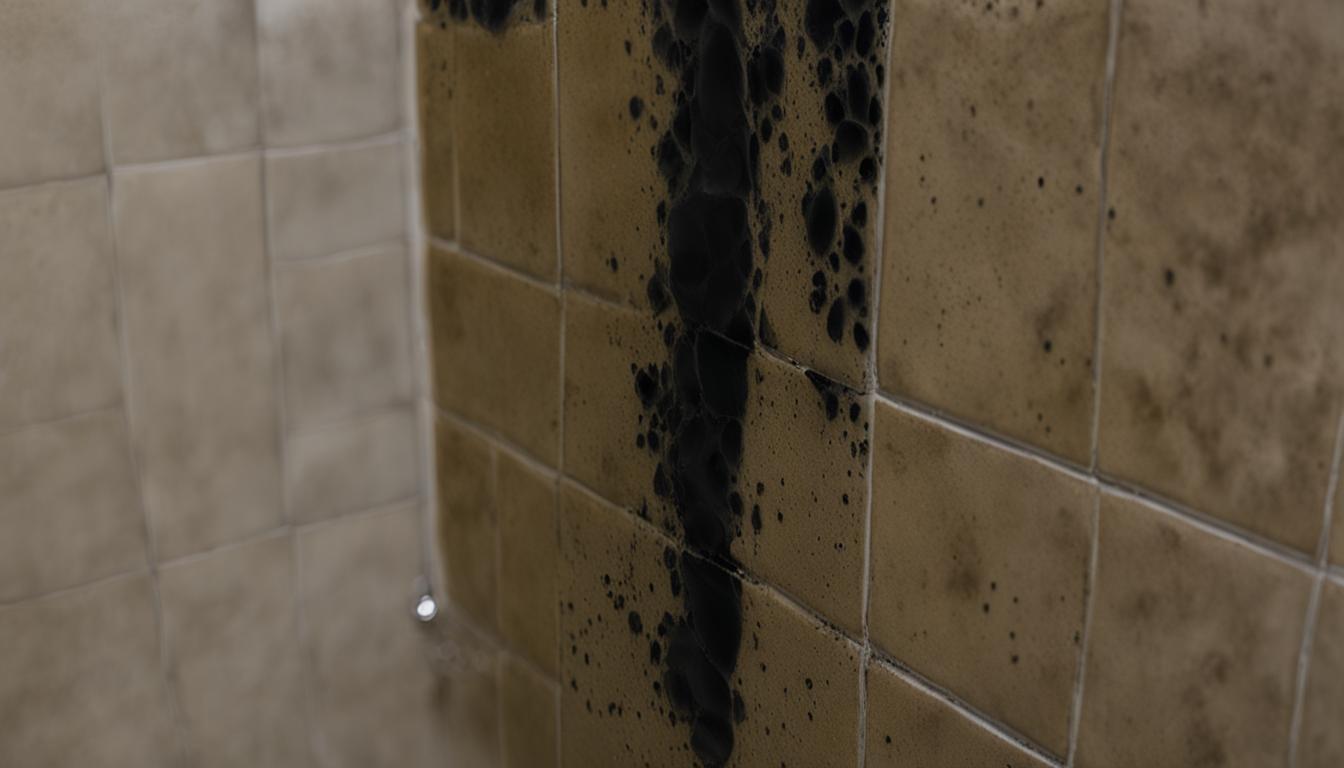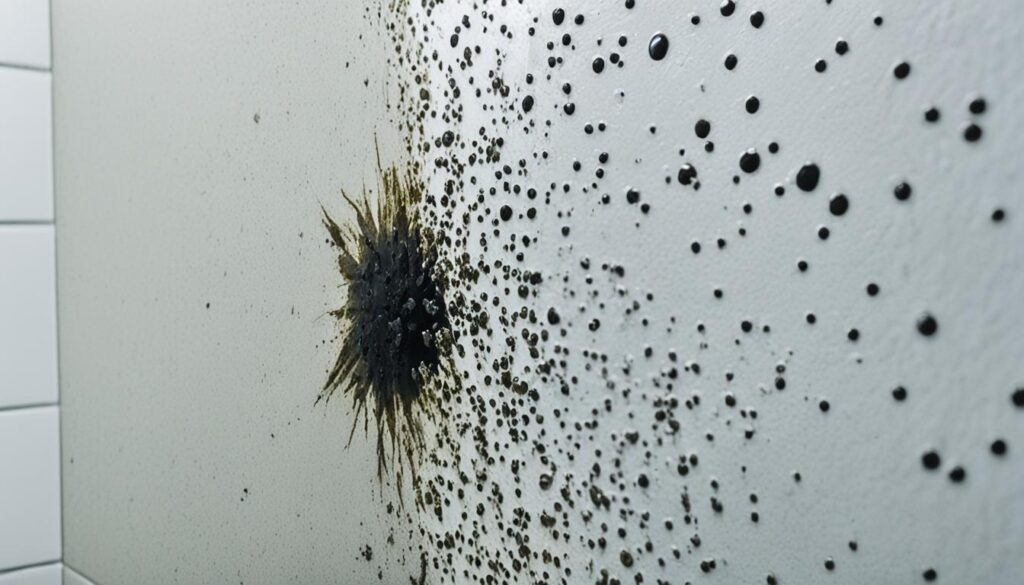
Eliminate Mold in Bathroom: Prevention & Removal
Welcome to our comprehensive guide on eliminating and preventing mold in your bathroom. Dealing with mold can be a frustrating and challenging task, but with the right strategies, you can create a clean and mold-resistant sanctuary. In this article, we will discuss the causes of mold, effective removal methods, and preventative measures to keep your bathroom mold-free.
Mold in the bathroom is a common issue that can lead to various health problems and structural damage if left unchecked. The presence of black mold is especially concerning, as it can be toxic and pose serious health risks.
By understanding the challenges of bathroom mold and implementing preventive measures, you can ensure a healthy and hygienic environment. Whether you are dealing with existing mold or want to prevent its growth, this guide provides expert tips and techniques to help you achieve a mold-free bathroom.
Key Takeaways:
- Mold in the bathroom can lead to health problems and structural damage if not addressed.
- Black mold is a toxic type of mold that requires prompt removal.
- Understanding the causes of mold is essential for effective prevention and removal.
- Regular cleaning, proper ventilation, and addressing moisture issues are crucial for maintaining a mold-free bathroom.
- If the mold problem is extensive or involves black mold, it may be necessary to consult professional mold remediation services.
Understanding Bathroom Mold
Before we dive into mold removal and prevention strategies, it’s crucial to understand the causes and types of bathroom mold. By familiarizing ourselves with these factors, we can effectively tackle the issue and create a mold-free environment for our bathrooms.
Causes of Bathroom Mold
Bathroom mold thrives in environments that are damp, humid, and poorly ventilated. The combination of moisture and lack of airflow creates an ideal breeding ground for mold. Here are some common causes:
- Leaky pipes or fixtures
- Poor ventilation
- Inadequate insulation
- Excess humidity from showers and baths
Types of Bathroom Mold
There are various types of mold that can grow in bathrooms, but the most common ones include:
- Aspergillus: This is a common type of mold that appears powdery and can range in color from white to gray.
- Cladosporium: This mold often appears as black spots on surfaces and can cause respiratory issues.
- Stachybotrys chartarum: Also known as black mold, this is a toxic mold that appears greenish-black and requires professional remediation.
Removing Mold from Your Bathroom
When it comes to removing mold from your bathroom, it’s important to use the right products and techniques. Here are some recommended methods:
“To effectively remove mold from your bathroom, start by using a mold cleaner specifically designed for this purpose. Look for cleaners that contain ingredients like hydrogen peroxide or bleach, as they are effective at killing mold and preventing its recurrence.”
Additionally, scrubbing the affected area with a brush and warm soapy water can help remove surface mold. Remember to wear protective gear, such as gloves and a mask, to avoid inhaling mold spores.
Using a best mold cleaner for bathroom will ensure effective mold removal and create a safer and healthier bathroom environment.
Bathroom Mold Treatment
Once you have removed the mold from your bathroom, it’s essential to take steps to prevent its recurrence. Here are some recommended treatments:
“To prevent mold growth in your bathroom, ensure proper ventilation by using exhaust fans or opening windows during and after showers. Keep the bathroom well-ventilated to reduce moisture levels and inhibit mold growth.”
Additionally, fixing any leaks promptly, insulating pipes, and using mold-resistant paint on surfaces can help prevent mold from reappearing.
In the next section, we will discuss how to identify and assess mold growth in your bathroom. Understanding the signs of mold and knowing when to seek professional assistance is crucial for effective mold management.
Identifying and Assessing Mold Growth
In order to effectively combat mold in your bathroom, it’s crucial to be able to identify and assess its growth. By recognizing the signs of mold, particularly black mold, you can take prompt action to address the issue and protect your health and home.
Signs of Mold:
- Visible patches of discoloration, ranging from black, green, or brown.
- A musty or earthy odor, especially in enclosed spaces such as shower cubicles or behind toilets.
- Peeling or bubbling paint, damp and discolored wallpaper, or disintegrating drywall.
- The presence of mold spores in the air, leading to respiratory problems or allergic reactions.
It’s important to note that black mold, also known as Stachybotrys chartarum, can be particularly harmful to human health. Its toxins can cause severe respiratory issues and other health complications. If you suspect black mold in your bathroom, it’s crucial to seek professional assistance for proper assessment and remediation.
When it comes to assessing mold growth in your bathroom, you can perform a visual inspection yourself or hire a professional mold inspector. Professionals have the expertise and specialized equipment to accurately assess the extent of mold contamination and identify potential hidden mold sources.
Professional Assistance:
“Mold assessment typically involves a thorough inspection of the affected areas, air sampling, and laboratory analysis. Professional mold inspectors have the experience and knowledge to identify the type of mold present and recommend the appropriate remediation measures. If you have severe mold growth or suspect black mold, it’s essential to consult a qualified professional for a comprehensive assessment.”
Evaluating Mold Growth
During the assessment process, the professional mold inspector will evaluate the severity of mold growth based on specific parameters, such as:
- The size and extent of visible mold patches.
- The presence of mold colonies behind walls, under flooring, or in hidden areas.
- The degree of structural damage caused by mold.
- The potential health risks associated with the mold species present.
The findings of the mold assessment will guide the remediation process and help determine the appropriate course of action to eliminate the mold effectively.
Remember, early detection and professional assessment are key to addressing mold growth in your bathroom promptly. By taking proactive steps, you can minimize health risks, protect your property, and maintain a clean and mold-free environment.

Mold Prevention Strategies
Preventing mold growth in your bathroom is essential for maintaining a clean and healthy environment. By implementing effective strategies, you can create a mold-resistant bathroom space. From proper ventilation techniques to sealing surfaces, here are expert tips to help you prevent bathroom mold:
Ventilate Your Bathroom
Ensure proper ventilation in your bathroom to reduce moisture levels and limit mold growth. Use exhaust fans or open windows during and after bathing to allow fresh air circulation. This helps remove excess moisture and prevents the buildup of condensation.
Control Humidity Levels
Monitor and maintain appropriate humidity levels in your bathroom. Ideally, the humidity should be between 30% and 50%. Use a hygrometer to measure humidity and consider using a dehumidifier if necessary.
Fix Plumbing Leaks
Regularly inspect your bathroom for any plumbing leaks and promptly fix them. Leaking pipes, faucets, or toilets can create a damp environment that promotes mold growth. Repairing leaks helps prevent water accumulation and reduces the risk of mold development.
Keep Surfaces Dry
Wipe down wet surfaces after use and ensure towels, bath mats, and shower curtains dry thoroughly. Moisture on surfaces provides an ideal breeding ground for mold. By keeping surfaces dry, you minimize the conditions favorable for mold growth.
Seal Grout and Caulking
Sealing grout lines and caulking around your bathroom fixtures creates a barrier that prevents water from seeping into porous surfaces. Use a high-quality grout sealer and silicone caulk to reinforce the waterproofing of tile showers, tubs, and sinks.
Use Mold-Resistant Products
When remodeling or renovating your bathroom, opt for mold-resistant materials and products. These include mold-resistant drywall, paint, and bathroom sealants. These specialized products are designed to inhibit mold growth and provide an extra layer of protection.
By following these mold prevention strategies, you can create a bathroom that is resistant to mold growth and enjoy a clean and healthy environment.

DIY Mold Removal Methods
Mold in the bathroom can be a persistent problem, but with the right knowledge and techniques, you can successfully remove it yourself. In this section, we will explore effective do-it-yourself mold removal methods that you can try in your bathroom. By following these safe and practical techniques, you can create a clean and healthy environment.
Before you begin the mold removal process, it’s important to gather the necessary tools and supplies. Here are some recommended products that can help you in removing mold from various surfaces:
| Surface | Recommended Product |
|---|---|
| Bathroom Tiles | All-Purpose Mold and Mildew Cleaner |
| Glass Surfaces | Vinegar Solution (1 part vinegar, 1 part water) |
| Shower Curtain | Bleach Solution (1 part bleach, 3 parts water) |
| Grout | Baking Soda Paste (baking soda mixed with water) |
Now let’s dive into the step-by-step process of removing mold from your bathroom:
- Put on protective gloves, goggles, and a mask to shield yourself from mold spores.
- Open windows or turn on a fan to improve ventilation in the bathroom.
- Identify the affected areas in your bathroom where mold is present.
- For bathroom tiles and glass surfaces, apply the recommended products and scrub gently with a brush or sponge.
- For the shower curtain, remove it from the rod and soak it in a bleach solution for 10-15 minutes. Then, scrub it with a brush before rinsing thoroughly.
- For grout, create a baking soda paste and apply it to the affected areas. Scrub with a brush and rinse well.
- After cleaning, thoroughly dry the surfaces to prevent mold from regrowing.
- Dispose of any cleaning materials or items that came into contact with mold properly.
Remember, if you’re dealing with extensive mold growth or black mold, it’s best to consult a professional mold remediation service to ensure safe removal.
Seeking Professional Mold Remediation
If your mold problem is extensive or if you’re dealing with black mold, it may be necessary to seek professional mold remediation services. While there are DIY methods for removing mold in the bathroom, hiring professionals can offer several benefits and ensure a thorough and effective solution.
Benefits of Professional Mold Remediation
When it comes to mold in the bathroom, especially black mold, seeking professional help can provide the following advantages:
- Expertise: Professionals have the knowledge and experience to identify the type of mold present and determine the most suitable remediation techniques.
- Safe and Efficient Removal: Professional mold remediation companies have the right equipment, protective gear, and cleaning agents to safely and efficiently remove mold from your bathroom.
- Preventing Further Spread: Mold spores can easily spread during the removal process. Professionals use containment methods to prevent cross-contamination and ensure that the mold doesn’t spread to other areas of your home.
- Addressing Underlying Issues: Mold growth in the bathroom is often a result of underlying moisture or plumbing issues. Professionals can identify and address these issues to prevent future mold growth.
- Peace of Mind: Hiring professionals gives you peace of mind knowing that the mold problem is being handled thoroughly and effectively.
Choosing the Right Mold Remediation Company
When selecting a mold remediation company, consider the following tips:
- Experience and Expertise: Look for companies with extensive experience in mold remediation and a team of knowledgeable technicians who understand the complexities of mold removal.
- Licensing and Certification: Ensure that the company is properly licensed and certified to perform mold remediation services. This guarantees that they follow industry standards and best practices.
- Insurance Coverage: Verify that the company carries liability insurance to protect you in case of any accidental damage during the remediation process.
- References and Reviews: Check for customer references and read online reviews to get an idea of their reputation and the quality of their work.
- Guarantees or Warranties: Inquire about any guarantees or warranties offered by the company to ensure that they stand behind their work.
By carefully selecting a reputable mold remediation company, you can confidently address your mold problem and restore a healthy environment in your bathroom.
| Comparison of DIY Mold Removal vs. Professional Mold Remediation | DIY Mold Removal | Professional Mold Remediation |
|---|---|---|
| Expertise | Varies depending on individual knowledge and research | Professionals have extensive knowledge and experience |
| Cost | Generally less expensive upfront | Can be more expensive, but offers long-term value and peace of mind |
| Effectiveness | May not completely eliminate the problem or address underlying issues | Thorough removal and addressing of underlying issues for long-term prevention |
| Safety | Can be risky without proper equipment and precautions | Professionals have the necessary equipment and follow safety protocols |
| Time | May require more time and effort | Efficient and timely removal process |
| Long-Term Prevention | May not address underlying issues effectively | Professionals identify and address underlying issues for long-term prevention |
Maintaining a Mold-Free Bathroom
Once you’ve successfully removed mold from your bathroom, it’s crucial to establish consistent practices that will help you maintain a mold-free environment. By implementing these maintenance strategies, you can prevent the return of bathroom mold and ensure a clean and healthy space for you and your family.
Regular Cleaning
One of the most effective ways to prevent bathroom mold is by practicing regular cleaning. Make sure to clean all surfaces, including walls, floors, tiles, and shower curtains. Use a mold-killing cleaner or a homemade solution of vinegar and water to thoroughly clean and disinfect the area. Pay particular attention to areas that are prone to moisture, such as around the sink, shower, and bathtub.
Proper Ventilation
Proper ventilation is essential for preventing mold growth in the bathroom. Make sure your bathroom is adequately ventilated by installing an exhaust fan or opening windows after showering or bathing to allow moisture to escape. This will help reduce the humidity levels in the room and prevent mold from forming.
Addressing Moisture Issues
To maintain a mold-free bathroom, it’s crucial to address any moisture issues promptly. Fix leaky pipes, faucets, or showerheads to prevent water accumulation. Additionally, use a squeegee or towel to dry the shower walls and bathtub after each use. Ensure that towels and bath mats are hung up to dry properly.
Tip: Keeping your bathroom well-ventilated can also help to reduce excess moisture. Consider using a dehumidifier if you live in a particularly humid climate.
List of Mold-Resistant Materials
When renovating or updating your bathroom, consider using mold-resistant materials to further prevent mold growth. These materials are designed to resist moisture and inhibit the growth of mold and mildew. Here are some options:
| Material | Benefits |
|---|---|
| Ceramic or porcelain tiles | Durable and resistant to moisture |
| Fiberglass or acrylic shower/bathtub units | Non-porous and easy to clean |
| PVC or vinyl flooring | Waterproof and resistant to mold |
| Waterproof paint or wallpaper | Forms a protective barrier against moisture |
By incorporating these mold-resistant materials, you can create a bathroom that is more resistant to mold and easier to maintain.
By following these maintenance practices, you can significantly reduce the risk of mold growth and maintain a mold-free bathroom. Remember, prevention is key when it comes to dealing with bathroom mold.
Conclusion
In conclusion, dealing with mold in the bathroom can be a persistent challenge, but it is not insurmountable. By arming yourself with the right knowledge and strategies, you can eliminate mold and create a mold-resistant sanctuary in your bathroom.
Understanding the causes of mold growth is crucial in order to effectively prevent its recurrence. Implementing prevention strategies such as proper ventilation, regular cleaning, and addressing moisture issues can go a long way in creating a clean and healthy bathroom environment.
Should you encounter a mold problem that extends beyond your capabilities, it is wise to seek professional assistance. Companies like Fix Mold Miami at 305-465-6653 specialize in mold assessments, prevention, and remediation, ensuring prompt and reliable services.




